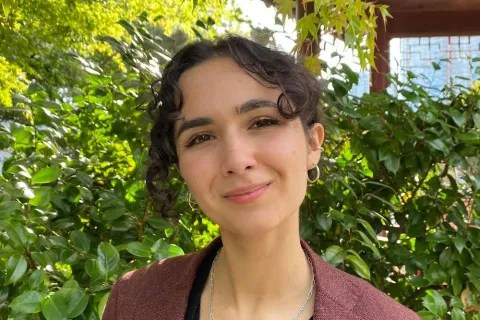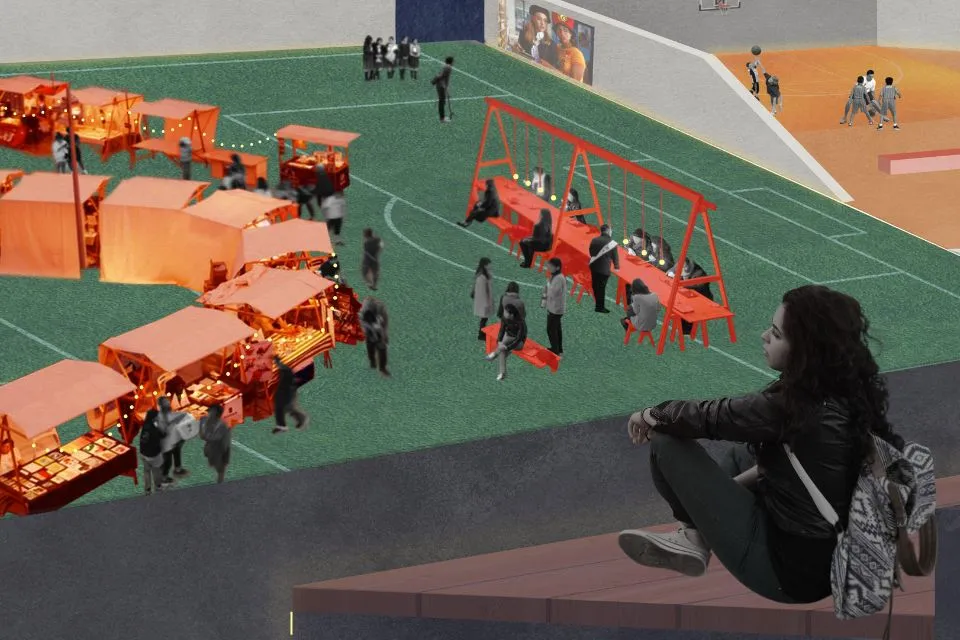"Stay open, curious and empathetic, and keep pushing yourself out of your comfort zone! So much of developing as a designer is about taking in the world around you."

Lisa Juliet Besnier
- Degree:
- Bachelor of Design in Architecture, Landscape Architecture, and Urbanism
- Grad year: 2024
- Program:
- Campus: Vancouver
I’m a recent graduate of the Bachelor of Design (BDes) program, and while I’ve been lucky to call Vancouver home for the past four years, I’m originally from Phoenix, Arizona. I left home to study abroad during high school in Changshu, China, and continued to seek out new experiences in the following years, first working in an animal shelter in Spain, and then in a neighbourhood house in Strasbourg, France.
It was during my time in France that I first started to truly engage with questions of environmental design and urban policy. Through the connections I made at the neighbourhood house, I found myself sitting in on meetings with urban planning activists and learning first-hand about the push towards new residential typologies and co-housing taking place in the community I was serving. Coming out of my gap year, I had caught a glimpse of what could be possible, and I knew that I had an interest in shaping cities. I started a liberal arts degree in the US, where I took courses on topics ranging from human geography, to visual art, to climate science, but I soon realized that I wanted to engage directly with environmental design, and ultimately decided to transfer to UBC.
Why did you choose to study Design at UBC?
The Bachelor of Design fundamentally appealed to me because it allowed me to continue to nurture my curiosity (in the end, I managed to also squeeze in a Minor in Urban Studies!) all while tackling work that felt much more directly applicable to my interests. Working across disciplines and scales within environmental design has been an incredible opportunity to apply my knowledge gained in the program and beyond, and led me to develop a keen interest in public place-making.
While in BDes, I’ve had the chance to work as an Undergraduate Teaching Assistant for the program’s introductory workshop, and as a Research Assistant. In the latter role, I had the honour of helping Professor Mari Fujita in her work, and along the way learned more about questions of heritage and community engagement in design. Outside of SALA, I also pursued climate activism, where I applied the technical skills I learned in the BDes to the work of visual communication.
How do you feel your degree has benefitted you?
I was initially drawn to the liberal arts because I wanted to avoid being siloed into a specialization, but struggled to find a coherent path, torn between studying processes of gentrification, the science of global warming and formal approaches to sculpture. If my previous educational experiences were rich, but fractured, BDes has truly been a synthesis, in which I’ve applied numerous skill sets to approach complex problems.
Working in architecture, landscape architecture and urban design, a continuing thematic thread has been the understanding that, regardless of scale, we are operating within systems with many actors, and that the places that we design for and on have their own histories, environments and agency. However, the flip side of being a generalist is that no one project can do everything, and serve everyone.
While my education in SALA has given me the tools to consider a wide range of information about complex systems, it has also given me the confidence to take a stance, and to synthesize information into a project that is both conceptually interesting and viable.
What made your time at UBC memorable?
As the core of the program, our design studios are inevitably periods of intense learning, each uniquely challenging and rewarding. One pivotal moment for my own understanding of design was in our urban design studio, DES 401. Taught by Professor Rana Abughannam and Cedric Jacques Yu, the studio challenged my understanding of the nature and scope of a designer’s role. The course emphasized the need for careful research and consideration of a community’s needs as a prerequisite to begin designing, and we were challenged to engage as much as possible with the neighbourhood we had as our site. We then applied that knowledge across vastly different scales—starting with the city and the neighbourhood, and ultimately narrowing down to a site and a building—an exercise that underscored the essential challenges and transformative potential of designing for interconnected systems.
I was also very lucky to be working in a talented and thoughtful group for the first half of the semester, and learned a great deal from my teammates, Miucci Yung and McNeil Fiesta. We ultimately proposed a plan to activate the quiet neighbourhoods of Kitsilano and Fairview at night, with my own project aspiring to create meaningful and joyful “after hours” spaces for youth, as a demographic often excluded from urban planning discourse.
What advice would you give a student in BDes?
During my time in BDes, I’ve learned immensely from professors, graduate students and my peers at SALA and UBC. My advice would be to take advantage of exhibitions and presentations put on by other programs, and to actively reach out to the people doing work that you’re curious about, be it professors or fellow students. Learning about how others approach the design process is deeply enriching, and there’s an incredible body of work being produced at SALA alone.
I especially came to learn this lesson while working on my senior design project, completed in DES 403 with Bill Pechet. I knew that I wanted to explore ‘queering’ suburban space as a starting point for my project, and as I worked to refine my topic and methodology, I reached out to others within the school for guidance. I was overwhelmed by the rich conversations that were generated by the project, and the diverse range of approaches in which others conceptualized queer space and suburban space. It can be intimidating to make those connections, but everyone is here to support your learning, and most people are very happy to share their thoughts and help you along on your own journey.
What are your future plans to make a difference in our world?
Approaching design through the lenses of social and climate justice, a key driver of my work up until this point has been my aspiration to create deeply social designs that foster a sense of community belonging. This has been with a focus on the critical role of third spaces, with the aim of ‘designing generously’: to not only accommodate needs but anticipate desires, and to create beautiful, joyful gathering spaces and amenities.
By serving the communities I’m part of and more, including the 2SLGBTQIA+ community, I hope to literally and figuratively make space for a greater range of people to have agency over the environments they occupy. In the future, I hope to continue exploring what acts of non-normative placemaking could look like, and to position myself as a partner and advocate, designing with rather than for the occupants of a project.
What are some contributions you would like to make when it comes to the future of work?
In the future, I hope to continue an ongoing push towards transdisciplinarity: doing so across design disciplines, but also learning from fields outside of design. My education in the BDes reinforced that design can sit at the nexus of other practices, with designers acting as coordinators and mediators. From working with community organizers and drawing on policies of engagement developed in the social sciences, to collaborating with researchers on the cutting edge of sustainability, we can continue to bring other practitioners together and learn from their work, offering valuable contributions by visualizing and applying their findings. In acting on the built environment, I believe that many of the solutions to essential problems we face today—be it meaningful social change or the development of a circular economy—demand this type of broad collaboration.




